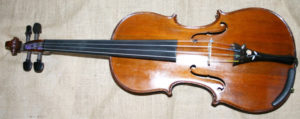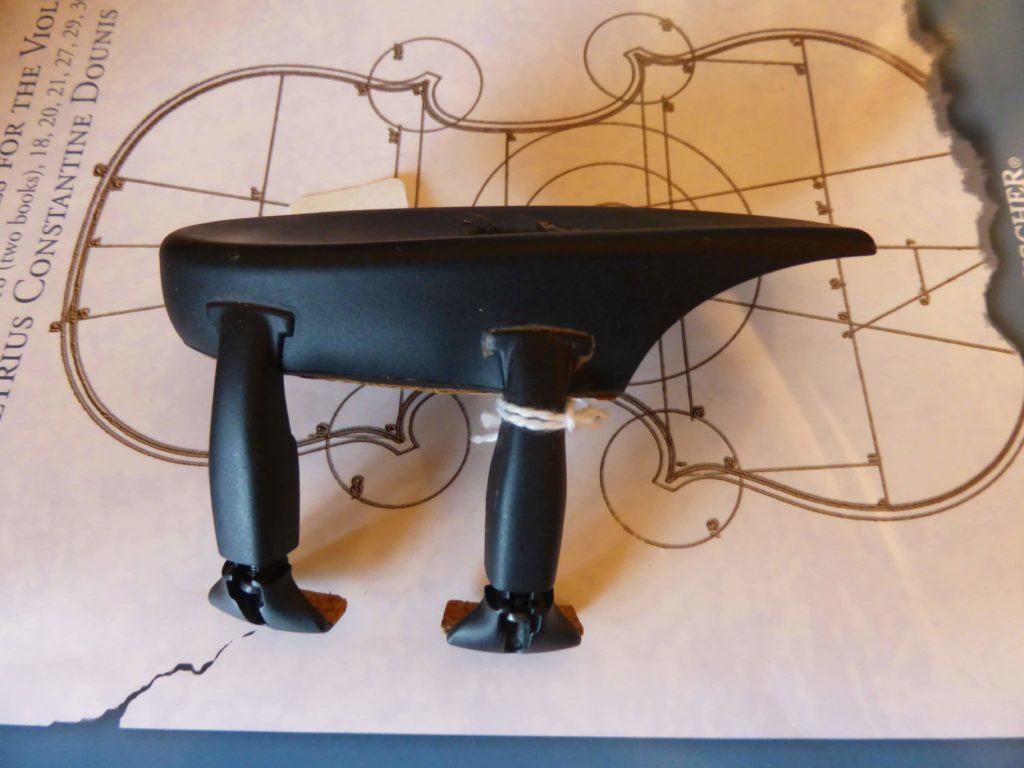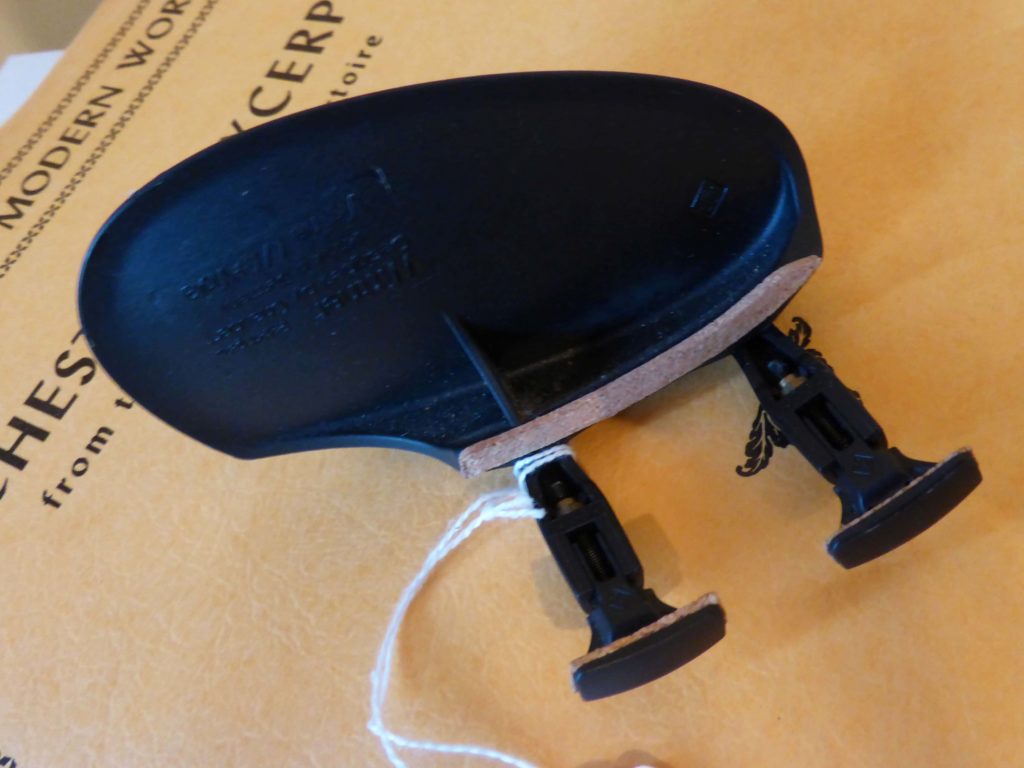The violinists’ chin rest and shoulder rest are accessories designed to facilitate ease of movement in violin playing. They should make holding the violin feel secure and comfortable. But how do you choose the right chin rest and shoulder rest? Should you make do with the chin rest that arrives with the instrument, or is it worth trying different shapes and sizes? And how do you know when a shoulder rest fits?

The chin rest was invented in the 1800’s by a violinist called Louis Spohr. Spohr is less well known today, but during his lifetime he was very famous – as famous as Beethoven. He was the leader of orchestras in Vienna, Frankfurt and Kassel, and also wrote a substantial number of compositions. He was responsible for the preservation and promotion of works by Bach and Handel, and the violin music he composed is difficult.
His invention of a small rest for the chin was designed to enable the left hand to move more freely between positions, giving security in higher registers and more mobility around the fingerboard. The first chinrest was very small and placed centrally over the tailpiece, but it immediately took off amongst violinists and has since evolved into a standard piece of violin playing equipment.

There are now many different designs of chin rest, all sorts of shapes and sizes, to enable players to find a comfortable fit. There are just as many different shoulder rests.
The shoulder rest is a more recent addition to the violinists’ toolkit and the history is less clear. In the August, 1921 issue of Etude magazine, an advert for the Mado Shoulder Rest can be found, whilst the August, 1923 issue of The Violinist contains a list of American violin makers, in which the Lockes' Violin Shoulder Rest is mentioned, stating that this particular shoulder rest was invented by Guyon Locke in April 1876. So just as Spohr’s chinrest idea was adapted and refined, many violinists had solutions for the shoulder rest, and each created something that suited their own playing.
The shoulder rest is also by no means a compulsory accessory. Some people prefer not to use one at all, claiming that it impedes the movement in their left arm, or stating, correctly, that fixing a shoulder rest to the violin prevents it from vibrating fully and mutes the sound.
It’s clear then that right from the earliest days of the chin rest and shoulder rest, no single design worked for everyone. This makes sense, because every violinist has a different shaped jaw, a longer or shorter neck, broad or sloping shoulders, a unique technique and a personal sense of comfort with the instrument. Ultimately, each violinist will find their own combination of chin and shoulder rest. It really is a matter of personal taste, as violinist Hilary Hahn explains in this video.
The Chin Rest
Many violinists will simply stick with the chin rest that came with the instrument. It’s all part of the same thing, right?
Student violins will come with a generic chin rest, often one that is not comfortable for anyone, and every instrument, right up to the best professional instrument will come with a chin rest already attached.
How do you tell if the chin rest doesn’t fit you?
A poorly fitting chin rest will be uncomfortable. It will cause you to tilt your head or even to reach forward with your head in order to hold on the violin with your jawbone. If your violin droops too much or you find that your chin is resting in the wrong place, the chin rest is not right for you. Compensating for a badly fitting chin rest with poor head position will cause neck aches, headaches and soreness in the jaw where the chin rest presses. It reduces the free movement of the arms and actually creates the exact problems that a chin rest is supposed to prevent. The violinist ends up adjusting their technique in order to hold on to the violin securely, limiting left hand freedom and reducing ease of shifting.

The only way to find a chin rest that fits is to visit your violin shop. Finding a comfortable shape may mean trying out many different rests. There are so many shapes available to fit different jaws, but the only way to know is to try them, making online shopping impractical for this purpose.
A well fitting chin rest will be both the correct height and the right shape for your jaw. It will allow your head to serve as a counterbalance to the weight of your extended bow arm. This will relieve your neck and shoulders of any unnecessary tension, preventing muscular pain and improving tone production.
A violinist with a round, fleshy jaw may find that a chin rest with a flat plate and a long, low ridge across the back is very comfortable. A player with a pointy jaw will need a totally different shape of rest. A rest that slopes downwards from the part nearest the neck will give good leverage, but one that is too high towards the left side near the ear will be likely to create skin irritations. If you need to nod your head exaggeratedly in order to touch the chin rest, it is too low. If you have to lift your head it is far too high. If your chin rest fits well but is a fraction too low, you can have it raised with the addition of a small piece of cork under its foot. If you have a long neck you don’t necessarily need a really high chin rest. Try a rest with a larger hump to match your jaw shape.

One aspect to consider, which is also important when choosing a chin rest, is the mobility of the left shoulder. If your left shoulder is flexible, you may prefer a chin rest placed to the left of the tailpiece. If it is less mobile, or if you have particularly narrow shoulders, you may prefer a centrally placed chin rest, or one that reaches more over the tailpiece.
Once you have a chin rest that fits well, you will find that your downward shifting and vibrato feel more secure. The chin rest will hold the weight of the instrument towards the collarbone, close to the spinal column, supporting the violin with the body’s natural balance. Your collarbones and arms will be free to move, the scroll height will naturally fall correctly and your violin will feel lighter.

There is also the option to cover your chinrest with chamois leather or a Strad Pad to prevent the skin from rubbing.
The Shoulder Rest
Choosing a shoulder rest is actually a bit more straightforward. Some players play without a shoulder rest, but some sort of support is often recommended for beginners as it helps to develop correct playing posture. The shoulder rest can help prevent the shoulder from hunching up under the violin, and can aid a comfortable neck position. It also removes the weight of the violin from the collarbone and gives space for the left arm to move freely under the violin.
Conversely, some players find that a shoulder rest can actually limit movement, though in this instance the shoulder rest is not correctly fitted. You should make sure when choosing a rest that there is not too much material pressing into the left shoulder or protruding down over the chest, because this will stop the natural rotation in your shoulder which you need to move around the fingerboard.
So how do you find the best shoulder rest for you?
There are many options. Some rests are soft and cushioned; others give a firm hold that helps keep the violin in place. Shoulder rests come in different shapes and sizes, and physical aspects such as shoulder breadth and the length of your neck are important considerations. Many rests are adjustable and ergonomically shaped to curve with the shape of your shoulder. They can also be positioned in various ways on the back of the violin to provide optimum support.
Again, the best way to find your set-up is to experiment. Many beginners start with a sponge or folded cloth fixed to the back of the violin with an elastic band. This is cost effective, but gives unreliable support and mutes the vibrations of the instrument considerably. Anything that covers a large surface area of the violin, particularly something made from an absorbent material, will affect the tone. A wooden shoulder rest in a design that sits away from the body of the violin will provide more resonance.
There are two basis reasons for using a shoulder rest. Firstly, it can help you to support the violin and secondly it offers comfort while playing. It effectively closes the space between the jaw and the shoulder that is not filled by the violin. You may find you prefer a soft sponge-like rest or perhaps you find a less padded, contoured, bar-shaped rest works better.

The correct height is important to consider too. If you have a longer neck, you are likely to need a taller rest, though most rests have adjustable heights. Foam rests and small sponges are much lower.
Ultimately, the shoulder rest you choose comes down to personal preference. Try different shapes and sizes and see what feels comfortable, but always remember to consult your teacher too. You may find that a rest that initially corrects one problem can cause another, and it is best to be really sure that your shoulder rest is suitable for your body shape and technique. You may also find that as your playing develops you want to try something different. Many violinists experiment with different shoulder and chinrest set-ups, and not many established players still use the exact same accessories they used as students. Be flexible and imaginative, and be open to experimenting, but be careful not to become obsessive. Ultimately, once you find something comfortable that does the job of supporting the violin, relax and enjoy your playing.

Existing set-ups can often be adapted for even more efficiency. A worn bar-type shoulder rest can be revitalised with the use of rubber bands for more friction and security. Some shoulder rests offer extra long adjustable legs. Shoulder rest feet can be rejuvenated with new rubber tubing. Nickel allergies can be avoided with titanium mounted, silver-plated or hypoallergenic plastic chinrests.
The shoulder rest and chin rest should work together by providing opposite forces. The shoulder rest supports from underneath the violin, and the chinrest gives the violin its position in regards to the body.
Ask yourself…
Please visit our sponsors:
London String School - Tuition for Adult Learners in London
MusicLand - Creative Music Products for Teachers and Learners
Please visit our sponsors:
FiddlerShop.com - Quality instruments at an affordable price
London String School - Tuition for Adult Learners in London
MusicLand - Creative Music Products for Teachers and Learners
